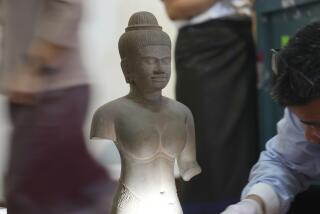U.S. Returns Antiquities to Turkey
- Share via
WASHINGTON — The U.S. government Wednesday returned to Turkey a trove of ancient art plundered from that country’s tombs and archeological digs, putting a small bite into the multibillion-dollar market for stolen antiquities.
The 133 objects--some almost 3,000 years old--were seized by the U.S. Customs Service while en route to a private gallery and auction house in Encino. Officials said the artifacts are the work of Greeks, Romans, Hittites, Byzantines, Phoenicians and Assyrians who lived over the millenniums in what is now Turkey.
Joel L. Malter, 68, the owner of the Encino gallery, pleaded guilty last week in Oklahoma City to charges of conspiring to receive stolen objects. Five antiquities dealers were arrested in Turkey as part of the case, which emerged from a sting operation run by U.S. Customs agents and Turkish police. The objects were returned after they were no longer needed as evidence.
The stone, ceramic, metal and glass artifacts, most of them quite small, were returned to Turkish Culture Minister Istemihan Talay at a lavish ceremony in the State Department’s Treaty Room, just outside the office of Secretary of State Madeleine Albright. Talay said that looting of ancient objects is a worldwide problem that the international community must confront.
In recent years, the U.S. government has retrieved and returned more than $30 million worth of stolen antiquities, admittedly a tiny fraction of the illicit trade. Although precise figures are not available, archeological experts estimate that trade in illegal artifacts totals about $4 billion annually.
Bonni Tischler, assistant commissioner of the Customs Service office of investigations, said the return of stolen art is a “win-win situation for everybody, except for the crooks.”
She said the tragedy of antiquities theft is that the objects “wind up in private collections, never to be seen by the public again.”
In a telephone interview, Claire Lyons, former vice president of the Archeological Institute of America, said that almost everything circulating in the private antiquities market is either forged or stolen.
“But with the EBay mentality, anything goes,” she said, referring to a popular Internet auction site.
Lyons said grave robbers and others who pillage archeological sites usually destroy far more than they take. Once a site has been disturbed, she said, its scientific value is greatly reduced.
The items returned to Turkey include teardrop vials, glass flasks, jewelry, small sculptures, buttons, seals, cross pendants and an oil lamp. U.S. and Turkish authorities decided to stage a public hand-over ceremony to dramatize the antiquities theft problem because Talay was in Washington on other business. Usually, returns are handled privately.
The Customs Service said the investigation of the Turkish artifacts began in October 1997, when agents in Oklahoma City received a tip that Sezai Portakalci, a Turkish employee of Incirlik Air Base, a facility in southern Turkey used for enforcement of the “no-fly” zone in northern Iraq, was offering stolen antiquities for sale.
Working with Turkish police, a customs agent traveled to Turkey in May 1998 to contact Portakalci, who sold him the artifacts. The next month, the customs agent showed the articles to Malter, who offered to buy them and asked if other items would be available from the same source.
Portakalci, Malter and four others were arrested.
Since 1970, the United States and most other countries have been trying to stop the trade in looted antiquities. U.S. law generally prohibits the sale of items that weren’t in museums before 1970.
The law is a sharp break from accepted practices during the 19th century, when museums competed for objects without giving much thought to how they came on the market. The most famous looted artifacts, the Elgin Marbles, were removed from the Parthenon in Athens and ended up in the British Museum, which still displays them.
New York’s Metropolitan Museum of Art recently returned to Turkey a collection of silver and gold objects known as the Lydian Hoard, settling a 25-year dispute over ownership.
More to Read
Sign up for Essential California
The most important California stories and recommendations in your inbox every morning.
You may occasionally receive promotional content from the Los Angeles Times.













